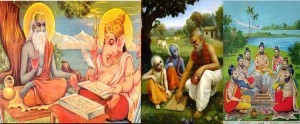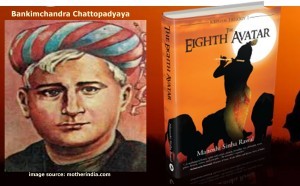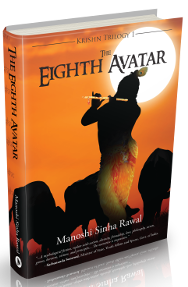Manoshi Sinha Rawal's Blog
June 15, 2016
Yes, I felt Krishn!
It may sound bizarre for many, unfathomable for a few and exaggeration for scores who read this piece. But, yes. I felt Krishn. It was my first encounter with the God of millions. In later years, He planted in me the seed of creativity from where words flowed spontaneously about Him, inciting me to type them, which turned into a saga of the God in print. And The Eighth Avatar was born.
It happened 12 years ago. It was four years past my attainment of my post graduation degree from Pune.
When I became a postgraduate, I planned to settle in Pune. I had been in Pune for only two years then. (Sometimes, emotional bonding at home binds you. And sometimes your place stops you.) From my birth till my graduation, I was always with my parents, my siblings, and with the warmth of my hometown Rupai Siding. This was the place that nurtured me, fostered me, cheered me, and made me trek through the thick and thin of life. And my decision was Rupai Siding. I taught in school. I taught in college. Two years passed by.
Fate had something else in store for me. My weak financial background compelled me to pursue my career in a happening city. Delhi conjured up with Rupai Siding, facilitating my relocation. And I ended up searching for a job in the capital city of India. I got recruited at a publishing house as a Trainee Editor.
I belong to the Bishnupriya Manipuri community, who are devotees of Krishn. Located around 25 kilometers from Rupai Siding is the district town of Tinsukia. More than 20 Bishnupriya Manipuri families have settled at a village called Lohari Kachari in Tinsukia. Community members from several regions in the district of Tinsukia donated for the construction of a temple dedicated to Lord Krishn and Lord Shiv at Lohari Kachari.
My visit to Rupai Siding was limited to twice a year for 15 days each. Every time I visited home, I visited the Lohari Kachari temple.
One and half year passed by. I visited home again after five months. And I visited the temple. The Bishnupriya Manipuri Pujari, who resided in the temple premises, told me that the dresses of Krishn and Radha should be changed. The dresses hadn’t been changed for over five years. He solicited me to be the sponsor, citing I worked in the city. I immediately replied in the affirmative. He advised me to get the dresses from Manipur.
My parents entrusted the task to a distant relative of ours. The total cost of the dresses and accessories of Krishn and Radha were estimated at Rs. 10,000. I was yet to get my remuneration. I told my parents that I would send the money as soon as I would get my salary. And I came to Delhi.
Though I was promoted to an Editor after a year after my joining, the amount I received every month was only enough to sustain myself with very little savings. I hadn’t changed my employer yet. If I would give Rs. 10,000, I would have to cut on my expenditures for the month. But happy that I would be donating for the Krishn I revere, thoughts about possible inconveniences vanished.
I visited the ATM the day I got my salary. I withdrew an amount of Rs. 10,000. The next morning, I went to the post office and sent the amount at my home address by ‘money order’.
The next day, I went to the ATM again to withdraw money to pay my house-rent and for daily expenditures. The balance amount showed Rs. 700. It was only the beginning of the month. I decided to borrow money from a friend if I needed it during the month.
After five days, my father called me up to tell that he had received the amount of Rs. 10,000 and that the person entrusted with the task had arrived with the dresses. I got another call from my father after two days that Krishn and Radha at the Lohari Kachari temple were decked up brightly in the dresses and accessories that I had sponsored. I felt elated.
A week later, I went to the ATM to withdraw some money. When I opened my bank account I was told that there should be a minimum balance of Rs. 500. I remembered I had merely Rs. 700 in my account. Hence, I could withdraw only Rs. 200. To my surprise, the balance after the withdrawal of Rs. 200 showed Rs. 10,500! I couldn’t believe my eyes. I checked it again. Rs. 10,500 was the balance amount! I immediately called up my father and asked him if he had really received Rs. 10,000 from me by money order. And he replied in the affirmative. I checked the balance amount of my account once again. And it showed Rs. 10,500.
The next day, I inquired my office accountant if he had deposited Rs. 10,000 in my bank account. The accountant nodded in the negative. I asked him to check to confirm. He did. And he affirmed that no transactions took place between me and my employer after the deposit of my salary for the month.
No one, not even my parents, except my office had my bank account details.
I went to the ATM to recheck. And it again showed Rs. 10,500. I walked home, covering the distance of 1 km from the ATM in slow steps, contemplating on how the miracle happened. Suddenly, I got goose bumps. My soul interacted with the infinity. A blanket of darkness enveloped me for a second. I got the answer. I felt Krishn.
August 13, 2015
The four ‘Yugs’ (Ages) in Hinduism – Satya, Treta, Dwapar, Kali
How many of you have been hearing the terminology Kali Yug quoted by people around you? The very depiction of a crime, vice or commitment of sin makes one utter Ghor Kali Yug! What is Kali Yug? How many Yugs exist in Hinduism?
Yes, we live in the Kali Yug! This Yug started around 3100 BCE. It was the time when Lord Krishn left His mortal activities. It was the time when the great Mahabharat war between the Kauravs and Pandavs came to an end.
Chronologically, the first Yug was Satya, followed by Treta, Dwapar, and now Kali respectively. During each phase of involution, symbolized by each Yug, there was a gradual loss of righteousness and decline of awareness of the inner self. During the Satya Yug, truth prevailed. The Treta Yug saw one-fourth loss of truth. Evil and dishonesty further prevailed during the Dwapar Yug with loss of half the truth. Kali Yug, which is the present Age, has been left with only one-fourth of truth. It is considered the Age of Darkness. The Dashavatar (10 Avatars) of Lord Vishnu incarnated nine times during the four Yugs, to eradicate evil. Kalki, the 10th Avatar of Vishnu is yet to incarnate in the present Kali Yug. According to the scriptures, Kalki will put an end to evil and dishonesty in the present Age.
The total duration of all four Yugs combined is 12000 years of the demigods (1 year of demigod = 360 years of a human being) with a timeline ratio of 4:3:2:1, as follows:
Satya Yug: 4800 X 360 = 1,728,000 years
Treta Yug: 3600 X 360 = 1,296,000 years
Dwapar Yug: 2400 X 360 = 864,000 years
Kali Yug: 1200 X 360 = 432,000 years.
The four Yugs make a cycle and two cycles make an arc, which is one full precession of the equinox. After the end of Kali Yug, Satya Yug will hold sway once again to start the second cycle.
Do you know the average life span of a human being during each Yug? During Satya Yug, the average human life span was 100,000 years with average height at 31 feet! During Treta Yug, it was 10,000 years at 21 feet. Dwapar Yug saw an average human lifespan of 1,000 years with height at 11 feet. During the Kali Yug, i.e. present Age, it is 100 years at 5.5/6 feet. The lifespan and height gradually declined from the beginning to the end of every Yug. So was there a gradual decline of truth, physical strength, emotional vigor, knowledge, wisdom, and dharma. During the present Kali Yug, people focus (have been focusing) more on material objectivity and incline towards the physical self rather than the inner self.
Maharishi Ved Vyas, in the Mahabharat, had said, “In the Kali Yug, the duties of the respective order shall disappear and men will become afflicted by inequity.”
At the end of the Kali Yug, the universe will be destroyed. And Satya Yug shall begin!
The Kali Yug started over 5000 years ago. Calculate, how many more years this Age will prevail!
August 1, 2015
‘Guru Purnima’ – From Lord Shiv to the Teachers We Revere Today
Guru Devo Maheshwaraha II
Guru Saakshat Para Brahma I
Tasmai Sree Gurave Namaha II
This Guru Stotra means – ‘Guru is the Representative of Brahma, Vishnu and Shiva. He creates and sustains knowledge. He destroys the weeds of ignorance. I salute the Guru.”
Do you know Lord Shiv was the first Guru of this world? Come every full moon day in the month of Ashadh, corresponding to July-August of the Gregorian calendar, this sacred day is celebrated as Guru Purnima. It was Lord Shiv who first transmitted the yogic sciences followed by Rishis (sages), era after era, Age after Age. Lord Shiv is thus christened the First Yogi or the first Guru. Other celebrated Rishis to follow were the Saptarishis (Kashyap, Atri, Vashist, Vishvamitra, Gautam, Jamadagni and Bharadwaj) that finds mention in the Veds and other Hindu scriptures. How many of you have experienced enlightened faces watching the seven stars of the Big Dipper – constellation in the night sky termed as Saptarishi Mandal by your parents and grandparents when you were children?
Guru Purnima is dedicated to Maharshi Ved Vyas. Today, Ved Vyas is revered as the greatest Guru of Hindu Dharma. Why? It is because he provided the world with the great knowledge of the scriptures. Till during his times, the Veds were passed from one generation to another by word of mouth. It was Ved Vyas who compiled them, penned them, and classified them into four parts – Rigved, Yajurved, Samaved and Atharvaved. It was because of the contribution by Maharshi Ved Vyas that written texts of the Veds are available. The Maharshi also authored the Mahabharat (the Rishi uttered and Lord Ganesh penned down the words), Srimad Bhagavatam, and the 18 Purans. He was the teacher of Dattatreya, the Guru of Gurus. Dattatreya, also called Trimurti, was the incarnation of Brahma, Vishnu, and Shiv.
Ved Vyas was born in the 3rd millennium BCE to Matsyagandha Satyavati and Rishi Parashar. He was grandfather to the Kauravs and Pandavs.
Other Significances of Guru Purnima:
For farmers, this day heralds the setting of the monsoon to infuse fresh life to vegetation. It is on this context that farmers celebrate Guru Purnima
Spiritual seekers start their meditation from this day
Many a spiritual seeker begin their spiritual lessons from this day
It is the beginning of the holy period of Chaturmas (four months), starting on Shayani Ekadashi (eleventh day of the first bright half of Ashadh till Prabodhini Ekadashi (the eleventh day of the first bright half of Kartik). Ashad corresponds to July and Kartik to October in the Gregorian calendar. During the Chaturmas, devotees involve in fasting, bathing in the holy rivers, austerities, and other religious activities.
Guru is the dispeller of darkness, of ignorance, leading aspirants towards the path to illumination, of enlightenment. In the present day context, our Guru represents our teachers, spiritual Gurus, our parents, our friends, our brothers and sisters, our neighbors, and anyone who has taught us something to better our lives.
July 24, 2015
Bankimchandra Chattopadyaya’s (author of Vande Mataram) interpretation of Krishn
Hare Krishn!
Who doesn’t know the author of Anand Math? He is Bankimchandra Chattopadyaya, a Bengali writer, poet and journalist. The very utterance of Vande Mataram and singing of this national song creates goosebumps! Vande Mataram was composed by Bankimchandra Chattopadyaya. During India’s freedom struggle, he significantly inspired the activists with Vande Mataram. He is the author of 13 novels in Bengali, which were translated into English, Hindi, and various other regional languages.
Bankimchandra Chattopadyaya carried out extensive research continuously on The Mahabharat for about 36 years. It was after the completion of his research that he wrote the biography of Lord Krishn. In his book, Chattopadyaya mentions that Lord Krishn was married to Rukmini only. He had only one wife. The 16000 plus wives that many a book describes are all false according to him. After marriage, both Krishn and Rukmini led a pious life for 12 years at Badrikashrama. They observed strict celibacy. It was after this harsh penance of 12 years that Krishn returned with his wife Rukmini to his kingdom and thereafter Pradyumn was born.
If one thinks logically, it would have taken Krishn over 10 years to marry 16000 plus wives with the condition that everyday he married four wives!
According to Chattopadyaya, Krishn did not play any love-games with Radha or any gopis. His research of The Mahabharat and the oldest scriptures let him write the book, throwing light on who the real Krishn was!
The Eighth Avatar draws some inspiration from Bankimchandra Chattopadyaya’s interpretation of Krishn.
Hare Krishn!
July 20, 2015
Dashavatar – Ten manifestations of Lord Vishnu
Hare Krishn!
The Eighth Avatar is a blend of mythology and fiction. The Krishn portrayed in many a book and the Krishn we know about and worship is not the real Krishn. His noble character has been stigmatized for long, portraying him as a lover, indulging in love-affairs with Radha and gopis. This is all false! He was a multi-faceted, accomplished, and ideal personality, endowed with all virtues and free from all blemishes. He was a Yogpurush, the savior, the protector, the Supreme Being, and an efficient ruler. He was a doting son. Krishn Trilogy depicts the story of Krishn from birth to death, delving on every aspect of his life besides refuting the many myths associated with him. The Eighth Avatar describes Krishn’s journey from birth till the fourteenth year of his life.
Ten manifestations of Lord Vishnu, collectively known as the Dashavatar (Ten Avatars), are mentioned in the Garuda Puran. The first four Avatars are Matsya (fish), Kurma (tortoise), Varaha (boar), Narasingh (half man-half lion), who appeared in the Satya Yug. The next three Avatars are Vaman (Brahmin in the form of a dwarf boy), Parashuram (sage with the axe), Ram (king of Ayodhya), who appeared in the Treta Yug. The eighth manifestation of Lord Vishnu is Krishn, who appeared in Dwapar Yug. Gautam Buddh (sage) is considered the ninth Avatar, who appeared in the present Kali Yug. The tenth Avatar, Kalki (eternity), is predicted to appear at the end of the present age.
According to some versions, Balaram is considered the eighth and Krishn the ninth Avatar. Few consider Krishn as equivalent to Lord Vishnu, thus omitting the manifestation.
Hare Krishn!







